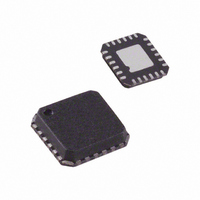ADL5372ACPZ-R7 Analog Devices Inc, ADL5372ACPZ-R7 Datasheet - Page 13

ADL5372ACPZ-R7
Manufacturer Part Number
ADL5372ACPZ-R7
Description
IC,RF Modulator,LLCC,24PIN,PLASTIC
Manufacturer
Analog Devices Inc
Datasheet
1.ADL5372ACPZ-R7.pdf
(24 pages)
Specifications of ADL5372ACPZ-R7
Design Resources
Interfacing ADL5372 to AD9779A Dual-Channel, 1 GSPS High Speed DAC (CN0018)
Function
Modulator
Lo Frequency
1.5GHz ~ 2.5GHz
Rf Frequency
1.5GHz ~ 2.5GHz
P1db
14.2dBm
Noise Floor
-158dBm/Hz
Output Power
7.1dBm
Current - Supply
165mA
Voltage - Supply
4.75 V ~ 5.25 V
Test Frequency
1.9GHz
Package / Case
24-VFQFN, 24-CSP Exposed Pad
Lead Free Status / RoHS Status
Lead free / RoHS Compliant
Other names
ADL5372ACPZ-R7TR
Available stocks
Company
Part Number
Manufacturer
Quantity
Price
Company:
Part Number:
ADL5372ACPZ-R7
Manufacturer:
AD
Quantity:
980
OPTIMIZATION
The carrier feedthrough and sideband suppression performance
of the ADL5372 can be improved by using optimization
techniques.
Carrier Feedthrough Nulling
Carrier feedthrough results from minute dc offsets that occur
between each of the differential baseband inputs. In an ideal
modulator, the quantities (V
are equal to zero, which results in no carrier feedthrough. In a real
modulator, those two quantities are nonzero; and, when mixed
with the LO, they result in a finite amount of carrier feedthrough.
The ADL5372 is designed to provide a minimal amount of carrier
feedthrough. Should even lower carrier feedthrough levels be
required, minor adjustments can be made to the (V
and (V
while the Q-channel offset is varied until a minimum carrier
feedthrough level is obtained. The Q-channel offset required to
achieve this minimum is held constant, while the offset on the
I-channel is adjusted until a new minimum is reached. Through
two iterations of this process, the carrier feedthrough can be
reduced to as low as the output noise. The ability to null is
sometimes limited by the resolution of the offset adjustment.
Figure 26 shows the relationship of carrier feedthrough vs. dc
offset as null.
Note that throughout the nulling process, the dc bias for the
baseband inputs remains at 500 mV. When no offset is applied
When an offset of +V
The same applies to the Q channel.
V
V
V
V
V
Figure 26. Carrier Feedthrough vs. DC Offset Voltage at 1900 MHz
IOPP
IOPP
IOPP
IOPN
IOPP
QOPP
–60
–64
–68
–72
–76
–80
–84
–88
–300 –240 –180 –120
= V
− V
= 500 mV + V
− V
= 500 mV − V
− V
IOPN
IOPN
IOPN
QOPN
= 500 mV, or
= V
= V
) offsets. The I-channel offset is held constant
IOS
IOS
IOS
= 0 V
is applied to the I-channel inputs
IOS
IOS
/2, and
/2, such that
V
P
IOPP
–60
– V
N
− V
OFFSET (µV)
0
IOPN
60
) and (V
120
QOPP
180
IOPP
− V
240
− V
QOPN
IOPN
300
)
Rev. 0 | Page 13 of 24
)
It is often desirable to perform a one-time carrier null calibra-
tion. This is usually performed at a single frequency. Figure 27
shows how carrier feedthrough varies with LO frequency over a
range of ±50 MHz on either side of a null at 1900 MHz.
Sideband Suppression Optimization
Sideband suppression results from relative gain and relative
phase offsets between the I-channel and Q-channel and can
be suppressed through adjustments to those two parameters.
Figure 28 illustrates how sideband suppression is affected by
the gain and phase imbalances.
Figure 28 underlines the fact that adjusting only one parameter
improves the sideband suppression only to a point, unless the
other parameter is also adjusted. For example, if the amplitude
offset is 0.25 dB, improving the phase imbalance better than 1°
does not yield any improvement in the sideband suppression. For
optimum sideband suppression, an iterative adjustment
between phase and amplitude is required.
The sideband suppression nulling can be performed either through
adjusting the gain for each channel or through the modification
of the phase and gain of the digital data coming from the digital
signal processor.
Figure 27. Carrier Feedthrough vs. Frequency After Nulling at 1900 MHz
Figure 28. Sideband Suppression vs. Quadrature Phase Error for
–30
–35
–40
–45
–50
–55
–60
–65
–70
–75
–80
–10
–20
–30
–40
–50
–60
–70
–80
–90
1850 1860 1870 1880 1890 1900 1910 1920 1930 1940 1950
0
0.01
2.5dB
1.25dB
0.5dB
0.25dB
0.125dB
0.05dB
0.025dB
0.0125dB
0dB
Various Quadrature Amplitude Offsets
0.1
PHASE ERROR (Degrees)
LO FREQUENCY (MHz)
1
10
ADL5372
100













